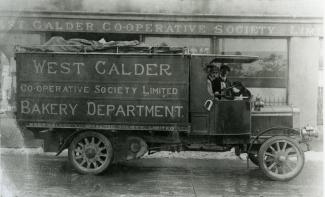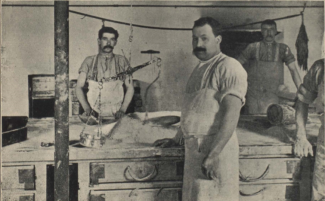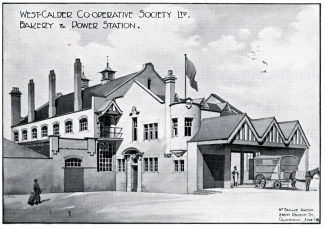A Growing Need for Bread

The West Calder Co-operative Society was formed in 1875. To begin with they had to buy all their stock, including bread, at wholesale prices. They soon realised that it would make more sense to set up their own bakery. When they built their first shop in 1879, they included a small on-site bakery. They soon outgrew it so they demolished the bakery and they built a new bigger premises on the same site.
When the Co-op started making their own bread one problem was quality - customers complained of doughy and burnt bread. Fortunately, the Co-op staff became better bakers and the bread started to taste much more pleasant.
The new bakery was soon working smoothly, making thousands of loaves every week. Horse-drawn vans delivered the bread to outlying villages and supplied the Societyʼs branch stores.

By 1890 the demand for bread was so great that a new bakery was built at the Pumpherston branch, and another small bakery was soon opened at Addiewell.
The East Calder Co-op bakery was taken over in 1904 to help meet the growing demand.
The small bakeries were all doing the same work which cost the Society a lot of money. In 1906 the Co-op managing committee decided that the only answer was to build a large, up-to date bakery to supply all their customers and stores. This site chosen was on Society Place, next to the Co-opʼs stables.
The New Bakery
The Society wanted a building they could be proud of, equipped with the most modern bakery machinery. They chose William Baillie, who had a strong connection with West Calder, as the architect. He designed a building in the fashionable Arts and Crafts style, with Scottish details like the turret on the front corner. Although the outside was decorative, inside it was designed as a completely practical industrial building.
The ground floor was the Bakehouse, with five ovens and a hotplate for baking scones and oatcakes. There was a complete range of machinery for mixing bread dough and making loaves, as well as a section for making cakes and confectionery. The floor above was the flour store, where the flour was blended and mixed ready for making into dough.
William Baillie had a long career as an architect. He designed many buildings in the Lothians, and in West Calder alone he was responsible for the Public Library, the War Memorial, the Junior and Senior Schools, as well as schools at Gavieside and Woodmuir.
The old bakery in West Calder had used a steam engine for power, but the new building had modern and efficient gas-powered engines in the basement. These were supplied from a gas making plant on the premise, making the bakery self-contained.
As well as powering the machinery the engines drove dynamos to generate electricity. The West Calder Society had installed a generator in their Central Premises in 1890. They were pioneers in making their own electricity. Three years later West Calder became one of the first towns in the country to have electric street lighting.
70 Years of Service
The new bakery started production in June 1909, and a grand opening ceremony was held on the 10th of July.
A large audience of local people gathered for the event; the official welcome was provided by West Calder Union Brass Band. The bakery was opened by Thomas Chalmers, President of the Society. A tea party with entertainment and many speeches was held later in the Polytechnic Hall. The bakery was very successful, serving the communities in the West Calder area for over 70 years.
The fortunes of the bakery changed in the 1970s. There was competition from supermarkets whilst Co-operative societies were becoming less important to local life.
The West Calder Society amalgamated with the West Lothian Co-operative Society in 1979. This meant that there were two bakeries in West Lothian, and the one in Bathgate was considered more profitable. The West Calder bakery closed in June 1980 with the loss of 19 jobs.
In 1984 the Bakery became West Calder Workspace a community owned project initially providing business start up units and support and later a job creation initiative and direct labour organization. This was one of Scotlandʼs pioneering Community Businesses (what today might be called a Social Enterprise). In the mid 1990ʼs the building was taken back by the Local Authority who ran it as business units until it closed between 2010 and 2012.




